ISSN ONLINE(2319-8753)PRINT(2347-6710)
ISSN ONLINE(2319-8753)PRINT(2347-6710)
| Ali Hassan1, Gaillan Husein2, Haider Yahai3 Ministry of science and technology/Directorate of material Research /center of laser research1, 2.3 |
| Related article at Pubmed, Scholar Google |
Visit for more related articles at International Journal of Innovative Research in Science, Engineering and Technology
Digital holography imaging method is presented for three-dimensional profile detection of the optical component. Although many of the remarkable properties of holography have been known for decades, their practical applications have been constrained because of the cumbersome procedures and stringent requirements on equipment. Holography may be used in various ways in the educational sector and can change the way people learn in the future. Digital holography offers a number of significant advantages such as the ability to acquire holograms rapidly, availability of complete amplitude and phase information of the optical field, and versatility of the interferometric and image processing techniques. Indeed, digital holography by numerical diffraction of optical fields allows imaging and image processing techniques that are difficult or not feasible in real-space holography. This research deals study of all parameters effects on reconstruct holography image using holovision software.
Keywords |
| Digital holography, reconstruct digital image, Holography |
INTRODUCTION |
| Holography, invented by D Gabor in 1948, is a two-step imaging technique based on the principle of optics interferenceand diffraction. Because hologram can be record not only the amplitude but also the phase information of object wave simultaneously, and the three-dimensional image of the object is obtained through reconstructed hologram. So ,Holography, a main metrological technique, has been applied in optical metrology. However holography application is much restricted by its tedious and no real-time hologram plate processing. With the development of holography and the combination of holography with computer, it is possible to transfer either the recording process or the reconstruction process into the computer. Firstly, computer is introduced in the process of hologram produced. This has led to computer-generated holography (CGH) [1], and the computer-generated hologram is then optically reconstructed and the wavefront information of object can be obtained. Secondly, hologram is reconstructed in computer. The on-line hologram or Fourier hologram recorded on a photographic plate is sampled, optically enlarged and then the digitized ‘conventional hologram is digitally decoded by special reconstruction algorithms, and the original field is reconstructed numerically and displayed on computer screen [2]. With the development of high-resolution CCD and fast computer, digital holography, the digital recording of holograms and the numerical reconstruction of the wave fields, has become possible. In comparison with classical holography, the main advantage of digital holography is that intensity as well as phase information of a holographically stored wavefront can be achieved directly and quantitatively in the numerical reconstruction process, with easy and highly sensitive recording of holograms and quick reconstruction and chemical processing being no necessary, thus increasing the flexibility and speed of the experimental process. So digital holography has been developed and widely applied in various fields of science and engineering, such as microscopy [3-5], Interferometry [6-7 ], 3D object recognition [8], practical measurement [ 9-13 ], and the research of deformation measurement and vibrating analysis [14-16], and so on. |
II. THEORY |
| The general set-up for recording off-axis holograms are shown in figure [1]. |
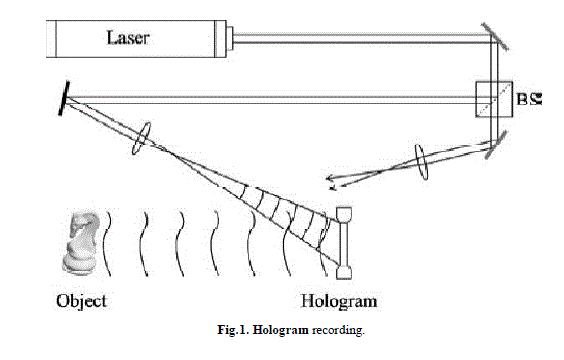 |
| Light with sufficient coherence length is split into two partial waves by a beamsplitter (BS). One wave illuminates the object, is scattered and reflected to the recording medium, e.g. a photographic plate. The second wave, called the reference wave, illuminates the plate directly. Both waves are interfering. The interference pattern is recorded, e.g. by chemical development of the photographic plate. The recordedInterference pattern is called a hologram. The original object wave is reconstructed by illuminating the hologram with the reference wave, figure 2. An observer sees a virtual image, which is indistinguishable from the image of the original object. The reconstructed image exhibits all the effects of perspective and depth of focus. |
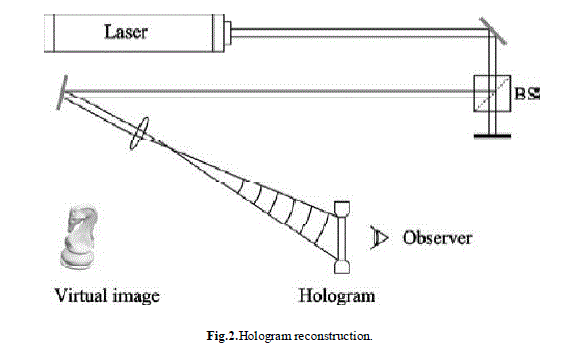 |
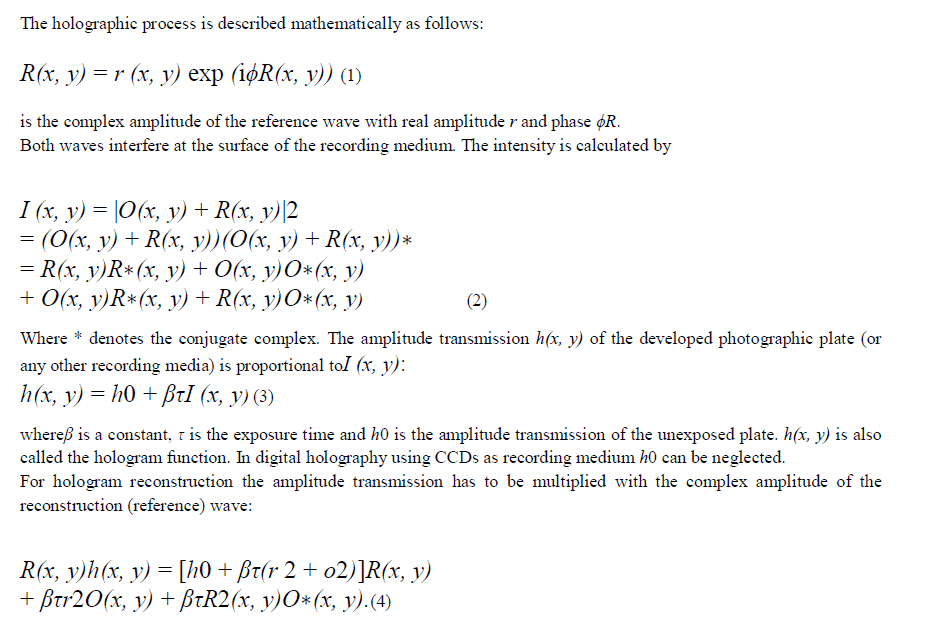 |
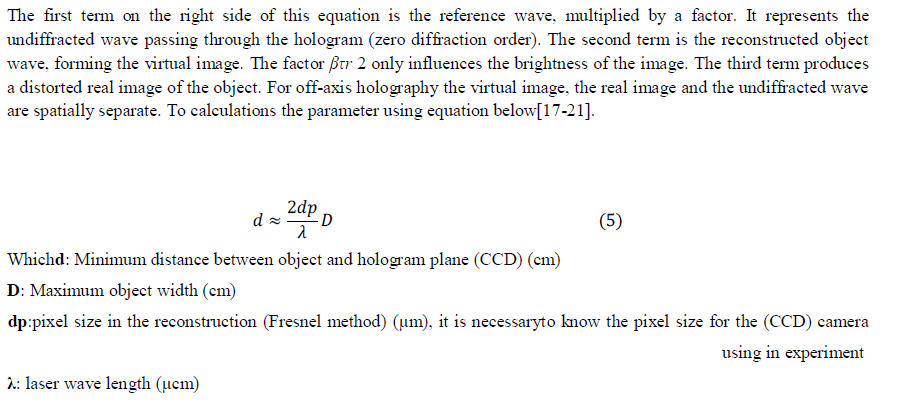 |
III. EXPERIMENTAL RESULTS AND DISCUSSION |
| When we study parameters effects on digital holography, the demonstration shows that how the software and digital holography can be used in optical interferometry. The experimental setup shows in Fig.1, the most common method of holography is called "in-line" holography, logically because all of the components are in a line. The image you get is actually the shadow of whatever lies in your field of view, so you cannot see the color of an object using using this method.The laser light provides all of the illumination, and other lights will detract from the quality of the hologram, so all of the images in this paper were taken in a mostly-dark room. The laser light must first be expanded and then collimated (i.e. parallel, the beam is not expanding or focusing). When the light passes through the test section, some of it hits objects and deflects, but some passes straight through. Other objects, such as dust on the lenses, will also deflect light.The combination of the direct light (this is called the Reference beam) and the deflected light hitting the recording medium creates an 'interference pattern', if the beams are coherent. The light that hit an object must travel further than the light that just went in a straight line. If this distance is greater than the coherence length of the laser, the two signals will be out of phase and the interference pattern will not appear. Coherence should almost never be a problem with inline holography because the difference between the distance traveled by the signal and reference beams is very small (< 1cm). This is why a laser pointer is sufficient to produce in-line holograms.Another reason why in-line holography is possible with a laser-pointer is the power required. Since you are only casting a shadow, the light does not have to be very bright. Other methods of holography (off-axis, back-scattering) record the light reflected from objects. This requires much more illumination. |
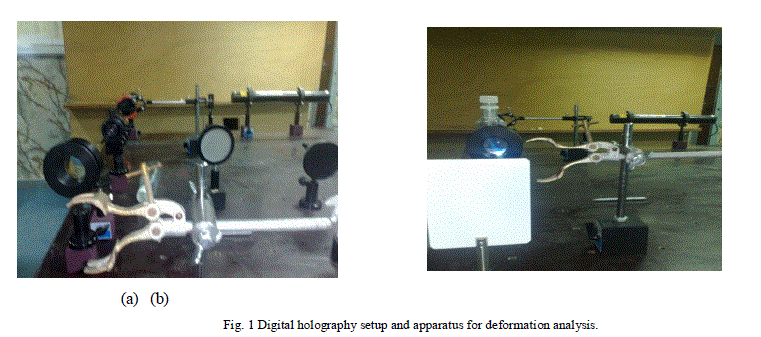 |
| In the first step recording and calculations all the important parameters effects using equation(5). Three recordings were made when the object was in the reference (i.e. undeformed) state: the hologram, the reference wave and the object wave. Theseare shown in Fig. 1(b).The object was a square metallic plate illuminated by a spherical wave froma He-Ne laser operating at 633 nm.Because of the large dimensions of the plate a negative lens was introducedafter the object. The lens created a smaller image of the plate, thus allowing the CCD camera (with its limited resolution) to resolve the interferencefringes the setup produced as in Fig.1 (a).Table (1) shows these parameters. |
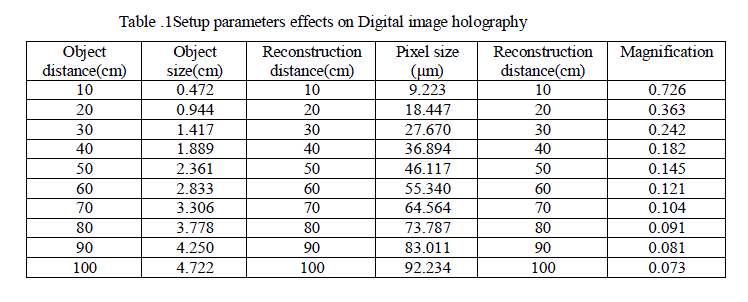 |
| The wavefields of both object states were reconstructed one at a time using the parameter values in Table.1. The reconstruction algorithm uses thereference and object recordings for filtering purposes. From table above we can see these parameters effect on reconstruction digital holography therefore, we can drawing these entire as in Fig. (4) below. |
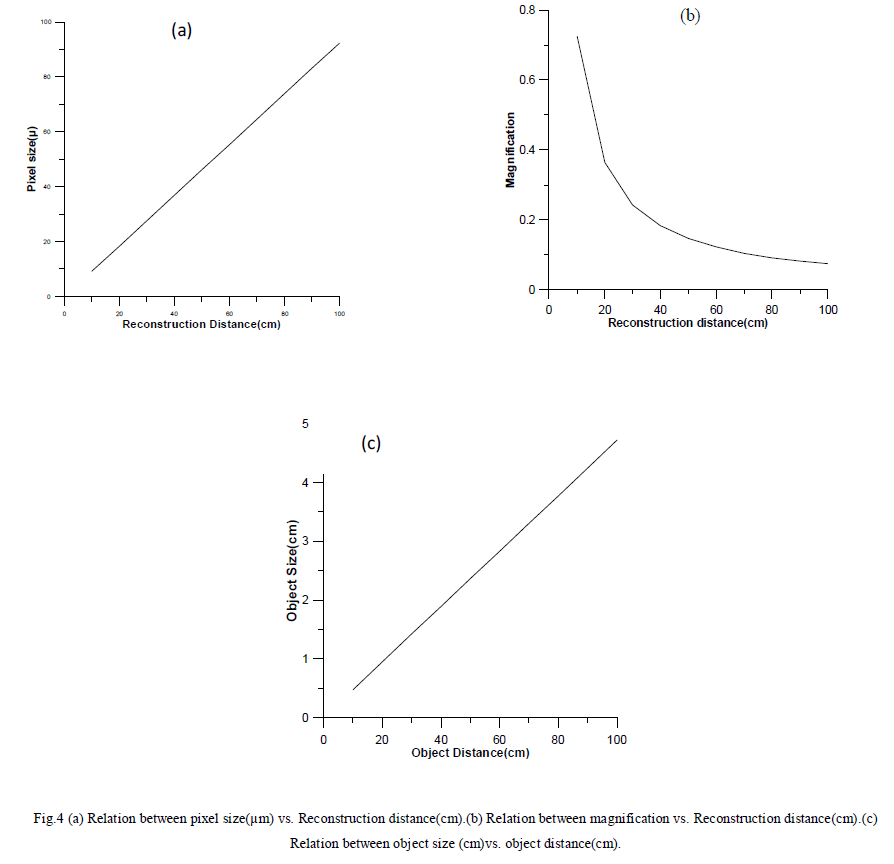 |
| Reconstructing a hologram means to bring it into focus at a specific depth.We have been careful to say ‘recording medium’ thus far, meaning either film or, for a digital camera, a CCD chip.However, from this point on we will assume a digital camera is being used. From Fig. (4-a) we can see that reconstruction distance increase with increase pixel size however, the pixel sizes in the reconstructed image depend on the recording distance z, the wavelength λof the used laser light, the dimension Δx, Δy of the pixel of the CCD and M×N of the number pixels on CCD. With given recording experimental system (CCD and λ), the pixel size in the reconstructed image depends on the recording distance, andthe pixel size increases with the recording distance increasing. |
| Holograms can also be created using an expanding laser beam, but the magnification will vary with a must be compensated for in the reconstruction program for this effect so we must use a collimated beam.The collimating lens is placed at its own focal distance away from the point source. So the distance between the lenses is the focal length of the collimating lens minus the focal length of the expanding lens. When lookat Fig (4-b) clearly see thatthe magnification vs. reconstruction distance (cm) take exponential curve where the magnification decrease when increase reconstruction distance. Clearly see from Fig (4-c) shows that Object distance represent minimum distance between the object and the hologram plane for a given object size. Specify the one-dimensional size (width or height) of the object, wavelength of the light and the detector pitch ofthe CCD chip,object sizes the maximum one-dimensional size of the object (width or height) for a given distance between object and CCD. Specify object distance, wavelength and the detector pitch of the CCD chip. The relation between them increases with increase object size. |
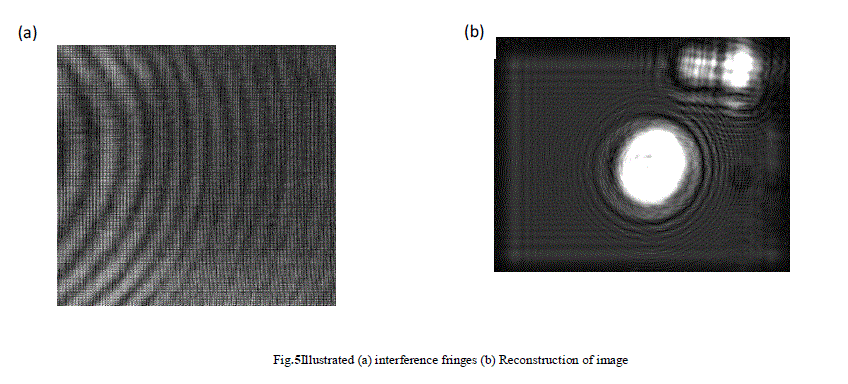 |
| The basis for this computation is a digital hologram, either captured directly with mobiledigital CCD camera or imported from a JPG, BMP, GIF or TIF file format from holovision software. Fig. (5-b) Shows the hologram image reconstructionfor theobject. The first hologram we successfully constructed is depicted in Fig.(5) using the setup above The hologram is 1200 pixels by 1600 pixels with a spacing of 6.7μ between each adjacent pixel as can be seen in the replayed image of Fig. (5). |
IV. CONCLUSION |
| The original goal of this paper was to consideration how the parameters can be effect on the reconstruction digital image. We learned that the entire holographic construction process was dependent upon all four steps outlined in our Experimentation Section above; defining the virtual object, computing the hologram fabricating and reconstruction. We recognize that the fabrication process is a major limiting factor in the construction of our holograms. In this research agenda has been prepared for all the variables that can affect the image formation process so is this research important in the process of alignment hologram imaging system after conducting a study on the variables affecting the final image. |
References |
|